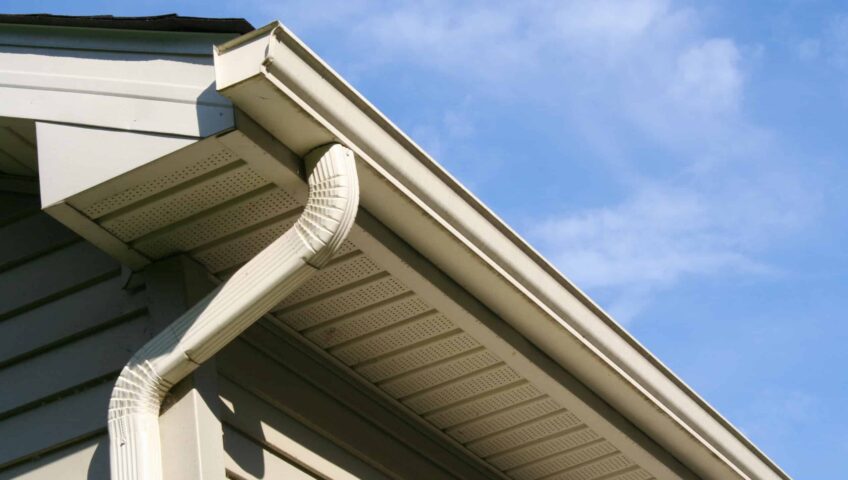Gutters are key to directing rainwater away from our homes and protecting our roofs, walls, foundations, and landscaping from water damage. Proper maintenance prevents costly repairs and ensures gutters work correctly. Neglecting gutters can lead to major structural issues, but with simple maintenance, we can extend their life and save time, money, and stress. In this post, we will share practical tips on keeping gutters in top shape and our homes safe for the long run.
Regular Cleaning: The Secret to Gutter Longevity
Keeping our gutters clean means they will last as long as possible. Regular cleaning prevents clogs and damages that can lead to costly repairs. Here, we will discuss why cleaning is essential, how often we should do it, and signs that our gutters need attention.
Why Gutter Cleaning is Important
- Prevents debris buildup that can block water flow and cause overflow.
- Protects your roof, foundation, and landscaping from water damage.
- Avoids pest problems—clogged gutters attract mosquitoes, rust, corrosion, and mold growth.
- Regular cleaning ensures gutters work properly and prevents costly repairs.
How Often to Clean Gutters
- At least twice a year – once in spring (to clear winter debris) and once in fall (to remove leaves).
- Homes with many trees may need cleaning three to four times a year.
- Check gutters after heavy storms to prevent clogs and ensure proper drainage.
Signs Your Gutters Need Cleaning
- Water spilling over the edges during rain – means clogged drainage.
- Plants or small trees growing in gutters – a sign of major debris buildup.
- Peeling paint or rust spots – indicates trapped moisture from clogs.
- Regular checks prevent damage and keep gutters working properly.
Inspection and Maintenance: Catching Problems Early
Gutter inspection and maintenance are key. By noticing issues early, we can prevent bigger problems later. Here’s how to inspect and care for our gutters.
Visual Inspections
- Inspect gutters at least twice yearly for blockages like leaves, twigs, and dirt.
- Look for rust, peeling paint, or loose fasteners, which means potential issues.● Check for gaps between seams and the roof; these can cause leaks.
- Regular inspections prevent costly repairs and keep gutters working properly.
Common Gutter Problems
- Clogs – Caused by debris buildup, causing overflow and water damage.
- Leaks – Often develop at seams or joints and need regular sealing.
- Sagging gutters – Due to heavy loads or weak supports, this means serious issues.
- Address these issues early, prevent further damage, and maintain proper function.
Minor Repairs
- Use a gutter scoop or hose to clear clogs and restore water flow.
- Seal small leaks with gutter sealant for a quick fix.
- Tighten or replace brackets to fix sagging gutters and ensure stability.
- Regular maintenance and timely repairs keep gutters working and damage-free.
Gutter Protection from the Elements
To keep our gutters in shape, we need to consider how different weather conditions can affect them. Protecting our gutters from heavy rain and snow buildup is key to long life. Here are several strategies to reduce damage and increase lifespan.
- Prevent clogs by blocking leaves, twigs, and debris while allowing water to flow.
- Mesh guards filter out most debris. Reverse curve guards direct water in and shed leaves.
- Regular maintenance ensures effectiveness and reduces the need for frequent cleaning.
Proper Gutter Slope & Installation
- Gutters need a 1-inch drop per 10 feet for proper water flow.
- Professional installation ensures correct alignment and prevents leaks and water pooling.
- Regular checks confirm that gutters are securely mounted and working properly.
Tree Damage
- Overhanging branches can scratch, dent, or damage gutters, especially in storms.
- Trim branches at least 10 feet away from gutters
- Regular inspections detect wear from tree pressure.
- Plant trees farther from the home to create a natural barrier against falling limbs.
Material Matters: Choosing Gutter Materials
Choosing the right material for gutters is crucial for their life and performance. Different materials have different benefits, and several factors must be considered before deciding.
Gutter Materials
Here are the available materials for gutters:
- Aluminum: Light and rust-resistant. Easy to install and comes in various colors.
- Vinyl: Affordable and low maintenance. However, it becomes brittle in extreme temperatures.
- Copper: Very durable and looks great. More expensive but worth it.
- Steel: Robust and can handle heavy rain. Tends to rust, so it requires coating.
When Choosing Materials
When choosing materials, we should consider:
- Climate: Areas with heavy rain or snow may need more sturdy materials like steel or copper.
- Budget: Knowing our budget helps us decide what materials are available.
- Maintenance: Some materials require more work than others. Copper needs polishing, while vinyl is low maintenance.
- Installation: Should we hire a pro or do it ourselves? Some materials are easier to work with than others.
Seamless vs. Sectional Gutters
We have two types of gutters to choose from: seamless and sectional.
- Seamless Gutters are one continuous piece. Since there are no joints, they don’t leak, look cleaner, and are easier to maintain.
- Sectional Gutters come in pieces, we connect. They are easier to install for DIY projects but have more seams, which can leak.
Gutter Maintenance Keeps Water Flowing
Gutter maintenance is key to longevity; a few simple steps can make a big difference. Regularly cleaning gutters to remove debris, inspecting them for damage like rust or cracks, and ensuring that downspouts allow water to flow can prevent costly repairs. Install gutter guards to keep debris out and maintain water flow. Trim trees and not plant them too close to the house to reduce buildup. By being proactive, we can extend the life of our gutters and keep them working for years to come.

